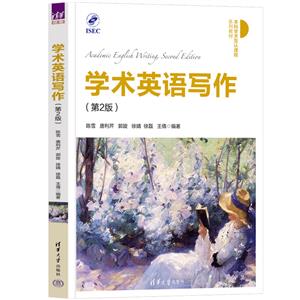-
>
中醫(yī)基礎(chǔ)理論
-
>
高校軍事課教程
-
>
思想道德與法治(2021年版)
-
>
毛澤東思想和中國(guó)特色社會(huì)主義理論體系概論(2021年版)
-
>
中醫(yī)內(nèi)科學(xué)·全國(guó)中醫(yī)藥行業(yè)高等教育“十四五”規(guī)劃教材
-
>
中醫(yī)診斷學(xué)--新世紀(jì)第五版
-
>
中藥學(xué)·全國(guó)中醫(yī)藥行業(yè)高等教育“十四五”規(guī)劃教材
學(xué)術(shù)英語(yǔ)寫(xiě)作(第2版) 版權(quán)信息
- ISBN:9787302662105
- 條形碼:9787302662105 ; 978-7-302-66210-5
- 裝幀:平裝-膠訂
- 冊(cè)數(shù):暫無(wú)
- 重量:暫無(wú)
- 所屬分類(lèi):>>
學(xué)術(shù)英語(yǔ)寫(xiě)作(第2版) 本書(shū)特色
本教材主要針對(duì)國(guó)內(nèi)非英語(yǔ)專(zhuān)業(yè)本科生、ISEC本科生、中外合作辦學(xué)大中專(zhuān)學(xué)生、非外語(yǔ)專(zhuān)業(yè)本科生而編寫(xiě),有助于學(xué)習(xí)者了解國(guó)際英語(yǔ)學(xué)術(shù)規(guī)范和學(xué)術(shù)英語(yǔ)寫(xiě)作的基本要求,順利完成在專(zhuān)業(yè)課學(xué)習(xí)中所涉及的論文攥寫(xiě)、研究報(bào)告等方面的學(xué)術(shù)英語(yǔ)寫(xiě)作任務(wù)。
學(xué)術(shù)英語(yǔ)寫(xiě)作(第2版) 內(nèi)容簡(jiǎn)介
遵循《國(guó)家中長(zhǎng)期教育改革和發(fā)展規(guī)劃綱要(2010—2020)》“通過(guò)教育國(guó)際化,深化高等教育改革”的指導(dǎo)思想,《學(xué)術(shù)英語(yǔ)寫(xiě)作》主要針對(duì)國(guó)際本科學(xué)術(shù)互認(rèn)課程[International Scholarly Exchange Curriculum (Undergraduate),簡(jiǎn)稱(chēng):ISEC] 而編排設(shè)計(jì),同時(shí)也適用于非英語(yǔ)專(zhuān)業(yè)本科生和希望留學(xué)的學(xué)習(xí)者。本書(shū)主要幫助 ISEC 本科生了解國(guó)際英語(yǔ)學(xué)術(shù)寫(xiě)作規(guī)范和基本要求,有助于學(xué)習(xí)者順利完成在專(zhuān)業(yè)課學(xué)習(xí)中所涉及的論文撰寫(xiě)、研究報(bào)告等方面的學(xué)術(shù)英語(yǔ)寫(xiě)作任務(wù),創(chuàng)造性地引導(dǎo)學(xué)生在寫(xiě)作時(shí)靈活運(yùn)用明辨性思維能力及技能,使學(xué)生能運(yùn)用規(guī)范的語(yǔ)言表達(dá)自己的學(xué)術(shù)思想。 《學(xué)術(shù)英語(yǔ)寫(xiě)作》圍繞學(xué)術(shù)論文寫(xiě)作的主要步驟、相關(guān)要求及方法展開(kāi),由十二個(gè)單元組成,每個(gè)單元涉及學(xué)術(shù)英語(yǔ)說(shuō)明文和論說(shuō)文寫(xiě)作的結(jié)構(gòu)和技能。本書(shū)主要從學(xué)術(shù)英語(yǔ)論文寫(xiě)作選題、材料收集與評(píng)估、提綱撰寫(xiě)、文章銜接與過(guò)渡、語(yǔ)言文體特點(diǎn)、寫(xiě)作規(guī)范、 參考文獻(xiàn)的標(biāo)注、出版流程以及答辯致謝等方面加以詳細(xì)分述。此外,附錄包含參考文獻(xiàn)常用格式指南以及論文寫(xiě)作的相關(guān)注意事項(xiàng)。
學(xué)術(shù)英語(yǔ)寫(xiě)作(第2版) 目錄
1. Critical Thinking Questions / 2
2. Introduction to Academic Writing / 3
3. Review: Types of Support in Academic Essays / 6
4. Plagiarism / 10
5. Writing Process of Academic Writing / 13
6. Self-Evaluation / 18
Chapter 2 Choosing a Title and Types of Academic Writing / 19
1. Critical Thinking Questions / 20
2. Purposes of Choosing a Title / 21
3. Principles for Choosing a Title / 22
4. Ways of Choosing a Title / 23
5. Types of Academic Writing / 28
6. Self-Evaluation / 30
Chapter 3 Source Research and Evaluation / 33
1. Critical Thinking Questions / 34
2. Types of Finding Information / 35
3. Research Skills / 37
4. Principles of Researching / 38
5. Criteria of Source Evaluation / 40
6. Note-Taking for Selected Sources / 43
7. Put it Together / 45
Chapter 4 Developing an Outline / 47
1. Critical Thinking Questions / 48
2. Introduction to Outline / 49
3. Points to Consider in Developing an Outline / 52
4. How to Write an Outline / 54
5. How to Evaluate an Outline / 61
6. Put it Together / 64
Chapter 5 Academic Language of Essay / 65
1. Critical Thinking Questions / 66
2. What is Academic Language / 67
3. Features of Academic Language / 68
4. Connecting Words and Signal Words in Writing / 72
5. Self-Evaluation / 82
Chapter 6 Introduction, Conclusion and Peer Review / 83
1. Critical Thinking Questions / 84
2. The Introductory Part / 85
3. The Concluding Part / 89
4. Peer Review / 93
5. Put it Together / 98
Chapter 7 In-Text Citation / 99
1. Critical Thinking Questions / 100
2. In-Text Citation VS. Plagiarism / 101
3. The Principles and Ways of In-Text Citation / 103
4. Quoting / 106
5. Paraphrasing / 110
6. Summarizing / 113
7. Put it Together / 118
Chapter 8 Writing the First Draft / 121
1. Critical Thinking Questions / 122
2. Thesis Statement / 123
3. Process to Write the First Draft / 128
4. Practice for the Introductory Paragraphs / 132
5. Practice for Body Paragraphs / 134
6. Practice for the Concluding Paragraphs / 136
7. Self-Evaluation / 138
Chapter 9 Abstract and References / 141
1. Critical Thinking Questions / 142
2. How to Write an Abstract / 143
3. Introduction of Reference / 146
4. APA Reference Format / 149
5. Self-Evaluation / 154
Chapter 10 Revising and Editing the Final Draft / 155
1. Critical Thinking Questions / 156
2. General Introduction to Revising and Editing / 157
3. Rereading Your Rough Draft / 158
4. Revising the Overall Structure / 159
5. Revising Sections/Chapters / 161
6. Revising Paragraphs / 163
7. Revising Sentences / 165
8. Revising Words / 167
9. Self-Evaluation / 170
Chapter 11 Research Proposal / 171
1. Critical Thinking Questions / 172
2. Introduction to Research Proposal / 173
3. Guidance and Structure of Writing a Research Proposal / 176
4. Put it Together / 181
Chapter 12 Thesis Presentation and Publication / 183
1. Critical Thinking Questions / 184
2. Thesis Presentation / 185
3. Preparing for Publication / 191
4. Self-Evaluation / 194
Appendix 1 APA Style / 195
Appendix 2 MLA Style / 200
Appendix 3 Chicago Style / 205
References / 210
學(xué)術(shù)英語(yǔ)寫(xiě)作(第2版) 作者簡(jiǎn)介
作者陳雪,教授,碩士生導(dǎo)師,主要研究方向?yàn)橛⒄Z(yǔ)語(yǔ)言教學(xué)與翻譯。曾擔(dān)任全國(guó)Pets口語(yǔ)考官,對(duì)外漢語(yǔ)面試員,Asia TEFL會(huì)員,省級(jí)微課專(zhuān)家。2012年、2019年分別在挪威奧斯陸大學(xué)和美國(guó)圣克勞德大學(xué)訪學(xué),注冊(cè)博士課程并獲學(xué)分。長(zhǎng)期從事英語(yǔ)口語(yǔ)、寫(xiě)作、教學(xué)法和翻譯研究工作。曾主持省級(jí)項(xiàng)目6項(xiàng),參與15項(xiàng);曾主持市、校級(jí)項(xiàng)目16項(xiàng),參與多項(xiàng)。在《社會(huì)科學(xué)戰(zhàn)線》等核心和省級(jí)期刊發(fā)表論文30多篇;曾主編、參編《英漢隱喻比較與翻譯研究》等著作和教材8部。多次獲省教學(xué)成果獎(jiǎng)、省社科優(yōu)秀成果、省教育科學(xué)優(yōu)秀成果獎(jiǎng)。
- >
中國(guó)歷史的瞬間
- >
莉莉和章魚(yú)
- >
有舍有得是人生
- >
史學(xué)評(píng)論
- >
煙與鏡
- >
伯納黛特,你要去哪(2021新版)
- >
【精裝繪本】畫(huà)給孩子的中國(guó)神話
- >
山海經(jīng)



















